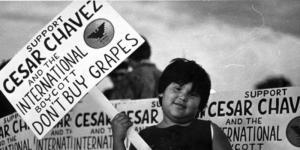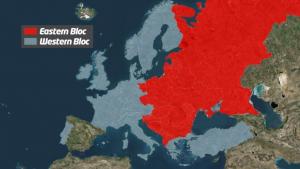
The years from 1929 to the end of the Second World War were disastrous ones for Europe. The Great Depression, the rise of dictators in several European countries, extreme nationalism and worship of blood and soil, six million Jews slaughtered in concentration camps—if this is any indication, then the modern Western world is both chaotic and demonic. Yet it was during these years and through movements of anti-Communism and anti-Fascism that the Catholic Church learned how to be modern.
Catholic modernism arose in the context of depression and the rise of totalitarian regimes in Soviet Russia and Germany. So says James Chappel in Chapter Two of Catholic Modern. (See Contents for all the posts in this series here.)
In fact, the Church learned two ways of being modern. Variants of the two, which one might call right and left, conservative and liberal Catholic modernism, have stuck with us. In the 1930’s the choice of which way to pursue depended on which enemy one considered the worse evil—Communism or Fascism. Anti-Communism took a form that Chappel calls “paternal Catholic modernism,” the subject of the present chapter. Those who were more concerned about Fascism and Hitler took up “fraternal Catholic modernism,” the subject of Chapter Three and my next post.
A new set of concepts
Few Catholics were Fascist or Communist—though more of the former than the latter. (p. 62) Larger numbers of Catholics were against both ideologies. But the Church directed by far the most effort against atheistic Communism. Anti-Communism left the Church’s earlier anti-Semitism largely unchanged, especially among the “paternal” group. The extent of the Church’s complicity in the special horrors of these years is debated. What’s undeniable is the treaty the Vatican signed with Hitler along with majority Catholic support for any anti-Communist dictator. With that comes the Church’s silence about the Holocaust. But, Chappel says, the attention this debate has received overshadows important developments in Catholic theology. (p. 61)
History-minded theologians at this time “dethroned the scholastic Middle Ages from their privileged status in Catholic thought.” (p. 61) By the 1930’s a return to that era of weak states seemed impossible, anyway. Rather than challenge the legitimacy of modern states, Catholics began to think about what religion needed from the state.
Accepting existence in a relatively private sphere, Catholics discovered a list of ways the state needed to act to protect that sphere: “human rights, human dignity, religious freedom, and antitotalitarianism.” This was
a set of concepts that allowed them to be ideologically, and not just pragmatically, committed to working with non-Catholics in support of secular political projects…. In place of rights of the Church, they spoke now of ‘human rights.’ In place of the dignity of the Church, they spoke of ‘human dignity,’ which accrued to all people, not only to Catholics. And in place of Catholicism’s privileged place in the polity, they began to speak of ‘freedom of conscience.’ (p. 61)
Family, economy, state, and three representative thinkers
In this chapter we see the pattern Chappel uses throughout most of the rest of the book. He deals primarily with three countries, Germany, Austria, and France. He chooses a representative thinker from each country. Each of these individuals deals primarily with one of three important issues: family, the economy, or the state.
- Mina Wolfring, from Austria, wrote about family. She “pioneered the Catholic embrace of the secular welfare state.”
- Theodor Brauer, German, “helped Catholics make peace” with modern economic models.
- Henri Massis, a French political thinker, explained why Catholics should favor “the secular, rights-defending nation-state.” (p. 68)
Each of these figures embraced a paternal, top-down, authority-driven version of modernism. Anti-Communism figured strongly in each.
- MinaWolfring: Family, birth rates, and welfare
A typical Catholic family produced lots of children, at least up to my parents’ generation. I don’t know if that distinction started in the 1930’s, but for Austrian Mina Wolfring it was the Catholic thing to do. It was an age when family values were important. These values included condemnations of homosexuality, abortion, and contraception, but those, which we would call conservative values, were common through much of society. Catholic family values in the 1930’s also included state financial support for families, in short, welfare. (p. 70)
In the 1930’s charity, even with the many Catholic charitable institutions, was not enough to help families in trouble. The Church had to give up its former vision of weak states suffused with universal Catholic values. Mina Wolfring was one who came to favor a strong state.
One of the tasks of that strong state was to provide financial support to families so that women would not have to work. That would have been a “great harm” (Pius XII) to families. Husbands should make enough money to support their families. But desperate families would need a proper welfare policy. That would also “keep families from turning in desperation to revolutionary doctrines,” according to the Pope. (p. 70) Anti-Communism and the need to whether the depression helped relieve the Church of its fear of strong, intrusive states.
A family allowance and an “unwaged mother’s allowance” were among Wolfring’s goals that actually saw the light of day. (p. 73) She was especially impressed with Mussolini’s family-friendly policies and Italy’s “aggressive policing of abortion.” Abortion, she argued would never be economically necessary with Italy’s social policy.
Nationalism, anti-Communism, anti-Semitism
Motherhood for much of Western Europe was patriotic. Wolfring compared it to military service. Large families, she said, were necessary for national health. I suppose the millions lost to the carnage of World War I had something to do with that. Worries about a declining birthrate pushed many toward Nazism. Among other sins charged to communism was sending women to factories. (p. 76-77) Wolfring was not a Nazi, but
Her insistent denigration of female economic agency, her organic language of the ailing body of the nation, and the militaristic language she used to describe motherhood paved the path for the widespread acceptance of Nazi family policy by Austrian women…. Austria’s bishops released a notorious declaration welcoming the Nazis. (p. 77)
Austria’s bishops welcomed the Nazi’s pro-family policies and attributed the “crisis of declining births,” to the “socialist Jewish government in Vienna.” (p. 77) Anti-Communism, anti-Semitism, an emphasis on the reproductive family, and a preference for strong authority went together in paternal Catholic modernism.
- Theodore Brauer, the managed economy, and state support for (men) workers
An old Catholic dream fell by the wayside in the 1930’s Here’s Pope Leo XIII in his 1891 encyclical Rerum Novarum:
[A]ssociations of Catholic workers and employers would come together to reach agreements over wages and working conditions in the spirit of charity and the common good. For Leo, in other words, the family was only one component of a dense web of institutions, which took care of interest-group mediation without state oversight. (p. 79)
In 1930 on that encyclical’s fortieth anniversary, Pope Pius XI, in Quadragesimo Anno, was praising state intervention in the economy. The old dream, apparently, couldn’t work in the new situation of depression. But an option to avoid at all costs, was pitting one class against another communist-style. Catholics, like German thinker Theodore Brauer, opted for a national system, called corporatism, that would represent various interests “without resort to class warfare.”
Corporatism’s anti-Communism was a middle way between laissez-faire capitalism and Communism. It imagined state mediation and state ordering of relationships in commercial affairs but not state ownership. Unions, long favored by Catholics, including Pope Leo, did not fit in this system. Nazi theorists leaned this way, too. Many Catholics ended up collaborating with the Nazi labor organization for that reason. These included a German theologian who has been one of my favorites, Josef Pieper. (Five of his books sit on my shelves, and I guess they’ll stay there.) Pieper praised “the far-reaching, and in some points astonishing consensus” between the Nazis and the Pope on labor issues. Besides that, both agreed on “the overcoming of the class struggle.” (p. 82)
Anti-Communism, anti-Semitism, pro-Capitalism
Private property rights became more important in Catholic thought. Pope Leo XIII had allowed “statist redistribution of superfluous property in the name of the common good.” In the 1920’s some Catholic economists “derived quite radical consequences” from this. In 1931 Pope Pius XI declared that this sort of redistribution could only be voluntary. Property was considered an idea provided by natural law, necessary to realize individual freedom. (p. 83) A strong state would defend individual rights against “those who wanted to strip them away,” specifically, communists.
Corporatism employed the language of social bodies and social health. That shaded off into the “kindred language of contagion and impurity.” (p. 84) Racist language “began to creep into [Brauer’s] writings.” He wrote about “blood and soil,” and a journal he edited complained the Jews were “the chief enemy of a Christian-German culture.” (p. 84)
Corporatism represented a major and lasting change in Catholic thinking about the economy. Catholics became more favorable to capitalism and the market, but also intervention by a powerful and not necessarily religious state. Catholics focused on human rights, including the right to family and property.
In the 1920’s Catholics had isolated themselves from possible allies, focusing on moral renewal and Catholic institutions. In the 1930’s, with corporatist thinking, Catholics formed many alliances. They supported, for example, Roosevelt’s New Deal, which had corporatist elements. (p. 90) Chappel concludes:
Catholics were willing to empower, like never before, the institution that had given them the greatest conceptual trouble over the years: the state. (p. 92)
-
Henri Massis’ defense of the West and of the state
In the 1930’s Catholics gave up their dream of a God-centered state. The idea of moral ideals filtering down from a Catholic imperial order and actually guiding whole economies and newly powerful states was too obviously impractical. Instead, Catholics focused on what they needed from the state. Their overriding concern for families led them to favor a well-regulated economy and state support for families in need. In addition, the state had to perform the essential functions of maintaining order and stability and protection from enemies. In the 1930’s only a unified powerful state could provide these, especially the last. So the state had to unite all its different elements. It had to treat all religions equally. It could not be Catholic.
Catholics began to be agnostic about which form of government was best as long as it wasn’t Communist. Paternal Catholic modernism could support FDR’s New Deal on the left and Generalismo Franco’s dictatorial rule in Spain on the right. Some Catholic had earlier managed to work with varying points of view, but only as a practical measure. In the 1930’s Catholics learned to do that as a matter of principle.
In 1922 Pope Pius XI had asked governments to admit their power comes from God. He talked about rights but mostly divine or institutional rights, not rights of individuals. Fifteen years later the same pope published the anti-Communism encyclical Divini Redemptoris.
This time, about 80 percent of the invocations of rights referred to the individual as their bearer. The encyclical, meanwhile, said nothing at all about the state’s duty to recognize God as the source of its authority. (p. 94)
The Church’s majority vision was conservative, sometimes fascist or racist, but definitely modern.
French ‘Poet of the West’
Like Chappel’s previous two protagonists, Wolfring and Brauer, Henri Massis evolved out of a firm anti-modernism. In the 1930’s a powerful French state able to meet the threat of Communism and a rising Germany was the only practical option. Massis began to call for a “truly strong state” — unlike the false totalitarianism of Soviet Russia and Nazi Germany. (p. 96)
Other European countries were on Massis’ mind, too. He envisioned a “Latin West” renewing European society. At first Hitler and Germany, whom the French loved to hate, were excluded from this vision. Mussolini, not yet Hitler’s ally, was in.
Before long many Catholics changed their mind about Hitler. They relied on Hitler’s anti-Communism, and he had begun describing his vision with Christian and Western terms. Joseph Goebbels, in particular, used the concept of the West with some regularity, both in the early years of Nazi rule and during the war. (p. 98-99)
Catholics by now were comfortable with a secular state and the Church’s separation from the levers of power. They claimed common cause with Protestants in “defense against anti-Christian enemies” and “the preservation of Christianity in our Volk.” Catholics began to show an appreciation for Martin Luther. (p. 99)
Catholic modernism and anti-Semitism
Anti-Semitism at this time came from this Catholic modernism, rather than from old doctrines about Jews, the killers of Christ. “The problem was that Jews were not properly secular.” (p. 104) Like the Communists they supposedly served, they failed to uphold the boundary between the sacred private and the secular public. The result was that Catholics “almost never protested racial legislation or violence.” The French Vichy government even “began passing anti-Semitic legislation before the Germans started pressing for it.” (p. 104)
Still Chappel imagines that Catholic modernists (here the paternal variety) worked a “monumental intellectual achievement.” (p. 105)
They provided not just pragmatic strategies but conceptual reasons why Catholics should make their peace with the modern state and the secular values of religious freedom and human rights. While many paternal modernists did support some form of fascism, the ideas themselves were not intrinsically fascist…. They could, therefore, survive the final defeat of fascism in World War II. (p. 106)
Paternal Catholic modernism had its deficiencies. Pope Pius XII praised this modernism in his Christmas massages of 1942 and 1944. Neither message, however, mentioned civil liberties or rights of minorities, especially Jews.
This was most apparent in one very loud silence: while ‘the innumerable sorrowing host of mothers’ received special attention, neither message spared a word for the specific suffering of Europe’s Jews. Catholics may have learned to be modern, but modernity can be cruel. (p. 107)
That goes for the majority form of Catholic political thought in the 1930’s, paternal Catholic modernism and anti-Communism. There was another form, an important minority, which Chappel discusses in the next chapter.
Image Credit: Live Law via Google Images












